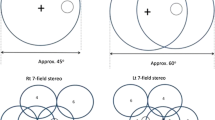Abstract
This paper discusses the new national guidelines for a systematic screening programme to detect sight-threatening diabetic retinopathy in the population of people with diabetes in England. A review of the literature examines the evidence base to support screening interventions and effective management and treatments in diabetic retinopathy. The current evidence supports the establishment of a digital retinal photography system using pupil dilation. A Policy Advisory Group has been formulated by the National Screening Committee to guide the meeting of this target in England. A conclusion is made that with increased effort and organisation, health care professionals can ensure that the screening programme is successfully implemented and rates of visual impairment and blindness caused by diabetic retinopathy can be reduced significantly. (Mol Cell Biochem 261: 183–185, 2004)
Similar content being viewed by others
References
Evans J, Rooney C, Ashwood F, Dattani N, Wormald R: Blindness and partial sight in England and Wales. Health Trends 28: 5–12, 1996
Aiello LP, Gardner TW, King GL, Blankenship G, Cavallerano JD, Ferris FL, Klein R: Diabetic Retinopathy (Technical Review). Diabetes Care 21: 157–159, 1998
Iochida LC, Castro AA, Uno F: Laser photocoagulation for diabetic retinopathy.The Cochrane Database of Systematic Reviews 1, 2003
World Health Organisation/International Diabetes Federation Europe. Diabetes care and research in Europe: The St.Vincent declaration. Diabet Med 7: 360, 1990
Younis N, Broadbent DM, James M, Harding SP, Vora JP: Current status of screening for diabetic retinopathy in the UK. Diabet Med 19: 44–49, 2000
Arun CS, Ngugi N, Lovelock L, Taylor R: Effectiveness of screening in preventing blindness due to diabetic retinopathy. Diabet Med 20: 186–190, 2003
Department of Health. The National Service Framework for Diabetes, 2003
Grimshaw GM, Baker R, Wilson AD, Thompson JR, Atkinson M: Report of the Inter-college audit of diabetic retinopathy screening. Clinical governance research and development unit. University of Leicester, Leicester, 1999
Hart PM, Harding S: Is it time for a national screening programme for sight-threatening diabetic retinopathy? Eye 13: 129–130, 1999
Klein R, Klein BE, Neider MW, Hubbard LD, Meuser SM, Brothers RJ: Diabetic retinopathy as detected using direct ophthalmoscopy, a nonmydriatic camera and a standard fundus camera. Ophthalmology 92: 485–491, 1985
Harding SP, Broadbent DM, Neoh C, White MC, Vora J: Sensitivity and specificity of photography and direct ophthalmoscopy in screening for sight threatening eye disease: The Liverpool Diabetic Eye Study. Br Med J 311: 1131–1135, 1995
Reenders K, de Nobel E, van den Hoogen H, van Weel C: Screening for diabetic retinopathy by general practitioners. Scand J Prim Health 10: 306–309, 1992
Gibbins RL, Owens DR, Allen JC, Eastman L: Practical application of the European field guide in screening for diabetic retinopathy by using ophthalmoscopy and 35 mm retinal slides. Diabetologia 41: 59–64, 1998
Leese GP, Tesfaye S, Dengler-Harles M, Laws F, Clark DI, Gill GV: Screening for diabetic eye disease by optometrists using slit lamps. J R Coll Physicians Lond 31: 65–69, 1997
Ryder RE, Vora JP, Atiea JA, Owens DR, Hayes TM, Young S: Possible new method to improve detection of diabetic retinopathy: Polaroid non-mydriatic retinal photography. Br Med J 291: 1256–1257, 1985
Ryder RE, Close CF, Krentz AJ, Gray MD, Souten H, Taylor KG: A ‘fail-safe’ screening programme for diabetic retinopathy. J R Coll Physicians Lond 32: 134–137, 1998
Cook HL, Heacock GL, Stanford MR, Marshall J: Detection of retinal lesions after telemedicine transmission of digital images. Eye 14: 563–571, 2000
Bachmann MO, Nelson S: Screening for diabetic retinopathy: A quantitative overview of the evidence, applied to the populations of health authorities and boards. Health Care Evaluation Unit, University of Bristol, 1996
Hutchinson A, McIntosh A, Peters J, O'Keefe C, Khunti K, Baker R, Booth A: Effectiveness of screening and monitoring tests for diabetic retinopathy-a systematic review. Diabet Med 17: 495–506, 2000
Bagga P, Verma D, Walton C, Masson EA, Hepburn DA: Survey of diabetic retinopathy screening services in England and Wales. Diabet Med 15: 780–782, 1998
James M, Turner DA, Broadbent DM, Vora J, Harding SP: Cost-effectiveness analysis of screening for sight threatening eye disease. Br Med J 320: 1627–1631, 2000
Wilson JMG, Junggner G: WHO Public health paper 34. World Heath Organisation,, Geneva, 1968
The Diabetes Control & Complications Trial Research Group. The effect of intensive treatment of diabetes on the development and progression of long-term complications in insulin dependent diabetes mellitus. N Engl J Med 329: 977–986, 1993
United Kingdom Prospective Diabetes Study. Quality of life in type 2 diabetic patients is affected by complications but not by intensive policies to improve blood glucose or blood pressure control (UKPDS 37). Diabetes Care 22: 1125–1136, 1999
National Screening Committee. A National Screening Programme for Sight Threatening Diabetic Retinopathy. National Screening Committee, 2003
Garvican L, Clowes J, Gillow T: Preservation of sight in diabetes: Developing a national risk reduction programme. Diabet Med 17: 627–634, 2000
Taylor R, Broadbent DM, Greenwood R, Hepburn D, Owens DR, Simpson H: Mobile retinal screening in Britain. Diabet Med 15: 344–347, 1998
Author information
Authors and Affiliations
Rights and permissions
About this article
Cite this article
Gillibrand, W., Broadbent, D., Harding, S. et al. The English national risk-reduction programme for preservation of sight in diabetes. Mol Cell Biochem 261, 183–185 (2004). https://doi.org/10.1023/B:MCBI.0000028754.70862.13
Issue Date:
DOI: https://doi.org/10.1023/B:MCBI.0000028754.70862.13




